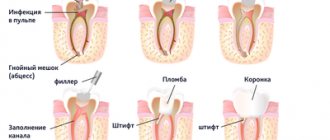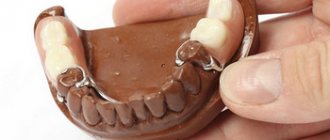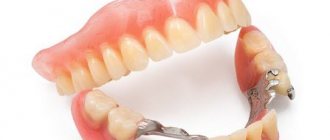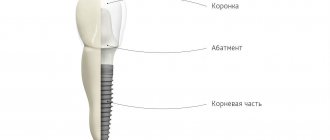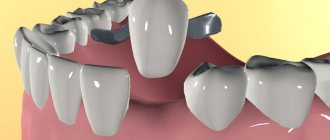Dental restoration is another popular niche in dentistry, which allows you to continue the life of a badly damaged natural tooth without prosthetics (and sometimes together with it). For this purpose, a pin is used - a special rod, which will be a new support for the destroyed tooth, and a complex tooth is built on it.
Tooth extension onto a pin
In most dental clinics, in the list of services you can find the column “Tooth restoration by extension (pin).” This procedure copes well with such tasks as correcting bites and correcting aesthetic tooth defects. Extension is a popular service, which is sometimes equated to artistic restoration.
Pins for teeth extension
In what cases is extension indicated?
The situation when a patient comes to the doctor and asks to have his tooth augmented, and the doctor just throws up his hands and recommends taking up prosthetics, is not uncommon. Patients, of course, are not professionals to independently determine what solutions exist for this or that dental problem. In reality, attaching a tooth to a pin is not a panacea, and it is indicated in a limited number of cases.
When is tooth augmentation recommended:
- chips and various cracks of teeth;
- various types of enamel damage;
- worn enamel;
- trauma with subsequent violation of the integrity of the bone tissue itself;
- greatly altered enamel color that cannot be changed by bleaching or cleaning;
- loss of a significant part of the tooth due to caries.
If the tooth is significantly damaged, it can be built up using a pin.
3 parapulp pins are installed in the root of the tooth
Of course, there are cases when restoring a tooth by building it onto a pin has contraindications. If the patient has an allergic reaction to one or another filling material, extensions are not performed. It happens that it is impossible to protect a certain area of the oral cavity from moisture, then it is also impossible to do artistic restoration, because the composite simply cannot dry out and, naturally, will not be fixed.
A direct contraindication is bruxism. This is what is called night grinding of teeth during sleep. Very often, it is precisely because of bruxism that cracks appear on tooth enamel, and if these cracks are removed by extension, then teeth grinding will lead to the destruction of an already restored tooth. But bruxism can be cured, the main thing is to consult a doctor in time.
Bruxism is a contraindication to attaching teeth to pins. In the photo there is a mouth guard against tooth abrasion
Pins should not be placed in children's teeth. It is not advisable to restore a tooth in this way if it (or neighboring teeth) has untreated caries. Of course, the general condition of the body is also taken into account: if the patient, for example, has a cold, his blood pressure has risen, his temperature has risen, the visit to the dentist should be postponed.
Children do not have teeth built up on pins
Indications and contraindications
Installation of a pin is recommended in the following cases:
– absence of visible coronal part of the dental unit;
– significant damage to enamel and dentin, impossibility of attaching a cementing filling;
– creation of a supporting part for the further installation of removable and non-removable orthopedic structures (crowns, bridges, etc.).
Pins are installed if the crown is damaged by more than half. Destruction can be caused by mechanical stress, trauma, or advanced forms of caries.
The described indications represent a likely example for tooth augmentation using a post. The dentist selects a treatment plan, offering the patient several restoration methods.
Pins are not installed in the following cases:
– destruction of the root part of the tooth, lack of support for the rod;
– inflammatory periodontal diseases;
– blood diseases, poor clotting;
– granulomas, cysts in the area of the problem unit;
– the thickness of the root walls does not exceed two millimeters.
Why does a tooth hurt after installing a pin?
Of course, pain in the area of the treated tooth is by no means a necessary phenomenon. But no one is safe from it, so you should be prepared for such unpleasant moments. Do not be afraid if for some time, literally a couple of hours after a visit to the doctor, the tooth begins to sag, as do the gums. However, during treatment, the tissues of the tooth and gums are affected; they are somehow, within the permissible limits, injured. Therefore, tolerable pain that does not last for several days is quite possible, there is nothing terrible about it.
After restoration, teeth may hurt a little
You can drink a packet of Nimesil, which will relieve discomfort.
Nimesil
If the pulp was removed during dental procedures, the pain may last for several days. Over time she will calm down. If nothing has changed, rush to the doctor. Prolonged pain may also indicate an allergic reaction to the material, which is also possible, and this also requires an early visit to the clinic.
Do you need a pin for a crown?
If the doctor insists on prosthetics, this already means that the tooth has undergone significant destruction. The crown helps restore the chewing function of the damaged unit and the aesthetics of the smile, this is especially true for the frontal region. Obviously, the prosthesis must have the necessary support. If there is a sufficient amount of natural tissue, the crown is placed directly on the tooth. In other cases, pins and stump inlays come to the rescue.
- Tooth decay of more than 30% is a good reason for installing a pin and crown.
- A chip of one of the walls of a tooth by 50% or more or a fracture at the root are indications for installing a core inlay and crown.
The technology also has limitations. A pin cannot be placed if there is untreated pulpitis, periodontitis and their complications (cyst, gumboil, etc.). Treatment will have to be abandoned if there are abnormalities in the structure of the tooth roots (too much curvature or thin walls). In some situations, the doctor is unable to unfill the canals after previous endodontic treatment, which also affects the possibility of installing a pin.
What is included in the cost of the tooth extension procedure?
A special issue is the cost of a particular dental procedure. Many patients wonder why the price of extensions is so high. But if you are provided with a whole range of services: with x-ray diagnostics, initial consultation, then there is nothing to be surprised at.
The cost of tooth extension on a pin includes:
- initial examination by a doctor, consultation with a specialist;
- X-ray diagnostics;
- computer modeling of the crown part of the tooth (this procedure is not always combined);
- cleaning the remains of the coronal part, as well as preparing it for installation of the pin;
- preparation of the root canal itself;
- antiseptic preparation of the hole;
- strong fixation of the pin;
- restoration of the crown part of the tooth - extension;
- surface finishing;
- diagnostics of the strength of the resulting structure;
- additional procedures.
The last point involves professional cleaning of all teeth and removal of dental plaque. Sometimes the tooth needs another adjustment if the patient himself complains of inconvenience. On average, restoring a damaged tooth by attaching it to a pin will cost the patient 2.5-3.5 thousand rubles.
Restoration of anterior teeth
When preparation for veneers is not necessary
Composite veneering is a method in which a composite layer is applied to the tooth, layer by layer, each time drying it with light. This allows the dentist to adjust the thickness of the veneer, shape the cutting edge and shape. Thanks to layer-by-layer application, the tooth does not need to be turned, the surface is simply ground. In all other cases, the enamel is ground to different depths.
There is another type of overlay that does not require turning - these are lumineers. They are made from special material, only in the USA. You have to wait for delivery, and if 1 lumineer breaks, then you also have to wait until it is made and sent. The Russian analogue, ultranirs, does not need to wait long, but if you need to correct the shape of a tooth, you will still have to grind it down.
Thin veneers can correct only minor defects: lighten teeth a couple of tones, cover dim pigmentation, mask the gap between teeth.
This method has disadvantages:
- Even ultra-thin veneers without grinding enlarge teeth
. With small teeth this is not noticeable, but if the teeth are large, then they visually look too massive. - to correct the shape of a tooth without grinding.
- It is difficult
to smooth the transition of the veneer to the gum ; bacteria can accumulate there, causing caries.
Are there any disadvantages to the extension procedure?
Of course, no dental procedure is without its downsides. And although extensions on a pin offer great opportunities for restoring damaged teeth, it also has its drawbacks. For example, in rare cases, installing a pin further destroys the tooth. If the doctor makes a mistake in treatment, caries may develop. Finally, the metal raw material for the rod can be damaged by corrosion.
- Tooth root extension
Sometimes pins destroy teeth even more
In some cases, in order to subsequently remove the pin, the entire tooth must be removed. An allergic reaction is another potential disadvantage of the procedure. And, what is most likely, after a certain period of time (depending on your luck), the walls of the tooth become thinner and it collapses. That is, a pin is not a guarantee that the tooth will always be in this form, and no further treatment or prosthetics will be required.
After restoration, teeth will still have to be treated or removed someday
Pros and cons of installing prosthetics with pins
Disputes about the advantages and disadvantages of dental prosthetics using pins can often be heard in dental offices. Sometimes there are quite convincing arguments that have no serious justification. Therefore, we bring to your attention a list of the real advantages of this method of prosthetics:
- it is possible to save a damaged tooth;
- loads are distributed not along the upper plane of the tooth, but along the entire length of the root;
- using aesthetic pins, dentin and enamel can be restored;
- a way to build up or lengthen a dental stump for subsequent installation of a ceramic crown.
This procedure also has its disadvantages. They can also be expressed as a corresponding list:
- high risk of root splitting;
- the difficulty of subsequently removing the pins from the root;
- If the tightness of the structure is violated, the likelihood of caries increases sharply.
Even if the pinning was successful, the patient continues to be observed by a doctor in order to promptly identify and stop some unwanted complications. This procedure can cause perforation, granuloma, swelling of the gums, or pain when pressing on the tooth. If these symptoms occur, you should immediately contact your dentist.
Is extension on a pin promising?
Of course, it is impossible to call the tooth extension procedure unpromising. This technique is constantly being improved, new technologies are being proposed that impress with their minimal trauma and safety for the patient. This relatively new practice is the installation of fiberglass pins.
Design of fiberglass pins "Rebilda Post" and pins from Russian manufacturers
Creating the final root canal configuration using a calibration drill
Calibration drill versus reamer
After processing the channel with a calibration drill
Silanization of the pin
Application of Futurabond DC adhesive using microbrushes
Restoration of the crown part of the tooth
Fiberglass pins are distinguished by their special plasticity, and this is really important, because the process of splitting the tooth root must be prevented, and the elasticity of the tooth contributes to this. Most often, fiberglass pins are installed in chewing teeth, since they bear the main, cantilever loads during food intake.
RelyX™ Fiber Post
The patient has the right to find out which pin will be installed, what determines the doctor’s choice, and how the extension procedure will take place. The doctor warns the patient about possible complications and talks about what needs to be done to prevent these complications from occurring.
Successful treatment!
Stages of implementation
At the first consultation, the oral cavity is examined and an x-ray is studied. In the absence of contraindications, the restoration process begins:
1. Both the type and method of pin installation are selected. The rod is selected taking into account the condition and type of dental unit (incisor, premolar, molar). The method of implantation is influenced by the integrity of the root.
2. The root canals are cleaned and expanded (by 2/3).
3. The rod is fixed, the canal is cemented.
4. Composite material is applied as a base for the crown.
5. The visible crown part of the tooth is installed. This can be a ready-made structure or layer-by-layer photopolymer. In the latter case, the material is applied in stages, fixing each layer with ultraviolet light.
6. The crown of the tooth is formed. Problematic areas during closure are identified and their surface is corrected.
7. The finished crown is ground and polished using a drill.
What does the manufacturer guarantee?
The warranty period for the integrity of the implant varies from manufacturer to manufacturer. Moreover, premium implants come with a lifetime warranty. Such products are very expensive.
Titanium implants from the mid-price segment are usually guaranteed for 10-25 years. Agree, the gap is very large. However, much here depends not so much on the quality of the implant, but on the prestige of the manufacturer.
Finally, the most inexpensive economy-class implants have a warranty period of 10 to 15 years.
However, in practice, everything does not look so rosy. The fact is that an economy class implant in one patient may last a lifetime, while in another patient a premium class implant may be rejected several months after surgery.
It should be understood that if the implant breaks due to a defect, the manufacturer will replace it. If the breakdown occurred due to the fault of the patient or the surgeon, then in this case the manufacturer will not replace the implant free of charge.
Practice shows that if the implant has served for one year, then its quality corresponds to the declared one and there is no longer any need to fear breakage. The main thing is to follow your doctor’s recommendations to avoid possible implant rejection.
Extension methods
If we talk about extension methods, there are two of them:
- straight,
- indirect.
The first allows you to restore the incisor during a one-time visit to the dentist. The composite material is applied over the dental crown. The use of this technique is possible only in the presence of minor damage.
As for the indirect option, specialized overlay materials are used for its implementation: veneers, crowns, as well as various inlays.
A specialist carrying out such restoration activities is obliged to find a solution that will be the most rational and the only correct one for each individual situation. The choice of technique depends, in particular, on the following parameters:
- root integrity,
- condition of the bone-jaw tissue,
- area of the dental crown,
- condition of the gum tissue.
Below we will discuss the most popular restoration methods, which include:
- filling,
- pins,
- tabs,
- veneers,
- photopolymers,
- photocomposites.
Sealing
This is the simplest answer to the question “how does teeth building happen?” This method is chosen when the patient’s bone tissue is practically intact. Most often, filling is used when the enamel is excessively thin, there are significant interdental spaces, and damage to the front teeth.
This method has not one advantage, but several. Firstly, thanks to the tandem of modern technologies and specialist skills, the result is very accurate. Secondly, the plastic composite used has many shades, among which you can choose a color scheme that is as close as possible to natural. Thirdly, the composite material has a high degree of adhesion, growing tightly and forming a single whole with bone tissue.
Extension on a pin
If the root is preserved, a pin is often used to carry out restoration work. The latter can have different shapes and sizes, which allows you to choose the most optimal option in strict accordance with the anatomical features of the patient’s oral cavity. Most often, this method of extension is used to eliminate chips on the front teeth.
Modern dentistry uses, as a rule, 4 types of pins:
- gutta-percha (flexible, but prone to rapid damage),
- carbon (has good strength characteristics and is relatively inexpensive),
- fiberglass (the most rational option for the restoration of front teeth),
- anchor (the strongest, most reliable and durable).
Tabs
In another way, this method of extension is called microprosthetics. Its essence lies in the use of specialized inlays, which in fact are individually made fillings.
If there is a carious cavity on the chewing part of the tooth, there is a high probability of empty cavities forming. Of course, in this case, you can also get by with regular filling. However, only an inlay can completely fill the cavity and also prevent changes in the bite.
Often, individual inlays are made of ceramic or porcelain. Such materials perfectly retain the original shade and do not lose other original characteristics, which, as has been said many times, is the most optimal combination.
Extensions using inlays are usually practiced in situations where most of the crown is chipped. If the area to be restored is invisible when smiling, an individual inlay can be made of metal, the prices of which are noticeably lower, and the practical properties are in no way inferior to ceramics and porcelain.
Veneers
We are talking about thin porcelain plates, the lining and fixation of which is carried out on the outer part of the tooth. This option is used for a variety of damage to the anterior units of the dentition.
As a result of using veneers, your smile becomes flawlessly even. Moreover, the material used usually lasts for about 10 years, without losing its original shade even with systematic smoking, as well as drinking coffee and all kinds of carbonated drinks that contain a coloring pigment.
However, veneers also have some disadvantages. Firstly, before installation, careful grinding of the tooth is required so that the latter does not protrude from the general row in the future. Secondly, due to the ideal proportions obtained as a result of such extensions, the naturalness of the smile is sometimes somewhat lost.
Photopolymer
The use of photopolymers is relevant in case of significant wear of the crown or extensive carious damage. To strengthen the result, during the process of filling the affected areas, the material used is exposed to ultraviolet radiation.
Important warning: if there is inflammation in the oral cavity, the use of photopolymers is contraindicated.
Composite
The main purpose of photocomposites is to eliminate cosmetic defects. The latter include cracks, chips, and other minor damage.
The material hardens under the influence of an ultraviolet lamp quite quickly, ultimately obtaining the required shape. One visit to the orthopedic dentist - and such a cosmetic issue is guaranteed to be resolved.
How not to make a mistake when choosing a clinic and dentist?
Before you trust a dental surgeon, you should make sure that he is licensed to perform dental implants. In addition, he must have permission from the SES. Take the time to clarify how experienced the specialist is and what reviews there are about his work. Keep in mind that the dental surgeon is required to show the patient his diploma, certificates and certificate of specialization.
As for choosing a clinic, first of all you need to make sure that it is equipped with the most modern dental equipment for dental implantation.
What does the clinic guarantee?
It is clear that the dental clinic cannot guarantee the quality of the implant. However, it provides a guarantee for the successful completion of the operation. Typically, the duration of such a guarantee ranges from one to two years. It should be emphasized that the guarantee is given only for the installation of a titanium root.
Practice shows that the risk of implant rejection remains for two years after implantation. Apparently, this is why clinics give a two-year guarantee on their work. As for rejection, this often happens due to a violation of the implantation technology. However, there are cases when the patient’s body rejected the implant for no apparent reason.
Statistics show that the cause of inflammatory processes that occur in the first weeks or months after surgery is a medical error or simply the surgeon’s negligence.
The failure of the implant to take root most often occurs due to the surgeon’s lack of proper experience. An unsterile instrument, an error in choosing the type of implant, or rough drilling of the bone - all this can lead to rejection of the titanium root.
At the same time, if implant rejection occurs after three to five years, then this is not the fault of the dental surgeon. Practice shows that the patient himself is to blame for this; he did not fully follow the surgeon’s recommendations, and they are always given in the most detailed form. Also, later implant rejection can occur due to emerging diseases.
Unfortunately, obtaining compensation in the event of implant failure is very, very difficult, if not impossible.
Warranty components
Warranties for medical (including dental) services are determined by such regulatory documents as the Law on the Protection of Consumer Rights, the Law on the Fundamentals of Public Health and the Rules for the Provision of Medical Services to the Population. It is worth saying that none of these documents stipulates specific warranty periods for dental prosthetics - this issue remains entirely at the discretion of the management of the dental clinic and the attending physician.
In each individual case, the duration of the warranty and the possibility of providing it in general are determined by the doctor individually, based on the following parameters:
- The general clinical picture in the oral cavity, taking into account the condition of the teeth and periodontal tissues.
- Identification of concomitant or systemic diseases that may affect the health of teeth and gums or cause changes in dental and periodontal tissues.
- The degree of patient compliance with the proposed treatment plan, hygiene procedures and medical recommendations for the care of prosthetic structures.
- Peculiarities of treatment: usually the warranty period is reduced or the guarantee is not provided in the case when the patient underwent orthopedic treatment from specialists in several clinics: for example, he prepared for prosthetics in one clinic, ordered the prosthesis in another, and went to a third for installation. This is a rare case, but still possible.
Taking into account these situations, the doctor can increase or decrease the warranty period for dental prosthetics compared to the average duration of the warranty period accepted in the clinic.
Inlay or pin: which is better?
The choice of support element depends on the specific clinical case. Both the pin and the core tab perform similar functions. However, each solution has its own advantages and disadvantages.
| Crowns on pins | Crowns on core inlays |
|
|
The stump tab is considered a more reliable option for chewing teeth and if it is necessary to install bridges. It is important to understand that this significantly increases the cost of treatment (the price per tab can reach up to 10,000 rubles). In addition, the manufacture of a stump insert requires an additional laboratory stage and appropriate manipulations.
Placing a crown on a pin can be recommended if the tooth does not have serious damage and there is no risk of pin breakage and root canal injury under the influence of chewing load. However, not all pins are suitable for the restoration of anterior teeth, especially if metal-free crowns are used. The crown and post on the front tooth should not contain metal if you want good aesthetics.
When installing a ceramic crown on a front tooth, the core inlay should also be made of ceramic.
Service life and warranty
First of all, you need to understand that guarantees for dental prosthetics and the service life of denture structures are different concepts. And if the clinic provided the patient with a guarantee for 2 years, this does not mean that after this period the prosthesis will have to be changed. The operating time of a prosthetic structure (that is, its service life) is usually much longer than the official guarantee, so the patient should not be afraid that the installed prostheses will only “last” for a year or two, and then they will have to undergo treatment again.

